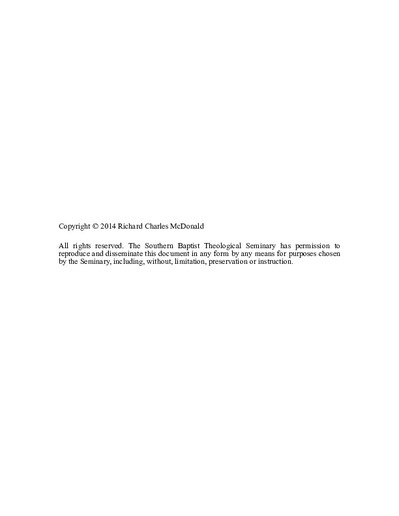Grammatical Analysis of Various Biblical Hebrew Texts According to a Traditional Semitic Grammar
Subject
Hebrew language--GrammarArabic language--Grammar, Comparative--Hebrew
Comparative linguistics
Abstract
Abstract
GRAMMATICAL ANALYSIS OF VARIOUS BIBLICAL HEBREW TEXTS ACCORDING TO A TRADITIONAL SEMITIC GRAMMAR
Richard Charles McDonald, Ph.D.
The Southern Baptist Theological Seminary, 2014
Chair: Dr. Russell T. Fuller
Although linguistic Hebraists are dissatisfied with traditional grammatical analysis, this dissertation demonstrates that traditional Semitic grammar--primarily based on Arabic grammar and grammarians--still provides the most simple, clear, and accurate description of biblical Hebrew grammar. Chapter 1 illustrates the role of Arabic grammar in the study of Biblical Hebrew grammar. From the inception of biblical Hebrew grammatical studies, Jewish scholars drew from the insights of Arabic grammar. For centuries afterwards, Jewish and Christian Hebrew grammarians followed this method. In recent decades, grammarians have turned to modern linguistic principles, leading to a misunderstanding of various points of Biblical Hebrew syntax.
Chapters 2 and 3 analyze the syntax of select verses in Genesis 2 and 3, respectively. Barry Bandstra's Genesis commentary in the Baylor Press series serves as the main point of comparison between the traditional Semitic approach and the modern linguistic approach. Each chapter introduces typical categories and definitions of traditional Semitic grammar, and critiques Bandstra's analysis when it contradicts Semitic grammar. Both chapters discuss a few main grammatical issues; in these discussions, other linguistic Hebraists are taken into consideration. For example, chapter 2 argues that the terms `nominative,' `genitive,' and `accusative,' are still valid grammatical categories in biblical Hebrew syntax, contra Jan Kroeze. Chapter 2 also contends that the pronoun הוּא is not a copula. Chapter 3 demonstrates that the Hebrew verb היה is not a copula but a real verb showing action, and that the energic suffixes on the imperfect do, in fact, have semantic value and do show emphasis.
In chapter 4, the analysis shifts to Ruth 1. Robert Holmstedt's commentary on Ruth from the Baylor Press series serves as the point of reference. There are three main discussions in the chapter. First, the chapter outlines biblical Hebrew word order in opposition to Holmstedt's claim that the typical word order is Subject-Verb. Second, the chapter demonstrates that the masoretic accents are crucial for biblical Hebrew syntax. Third, the chapter critiques Holmstedt's theory that the particle ⚀הַ marks headless relative clauses. The remainder of the verses are utilized to highlight traditional analysis or to contradict Holmstedt.
Appendix 1 outlines Geoffrey Khan's use of comparative Semitics to defend his copula pronoun theory. The excursus contends that Khan reinterprets Semitic grammar through discourse analysis, and that his copula pronoun theory cannot be substantiated. Appendix 2 differentiates between the participle as a verbal adjective (the traditional Semitic definition), and John A. Cook's placement of the participle in the class of `adjective.' This appendix maintains that the participle cannot be included in the biblical Hebrew verbal system. Appendix 3 responds to the external reader's critiques regarding the author's Arabic descriptions, the analysis of the reflexive Niphal, the use of the masoretic accents, and casus pendens.

